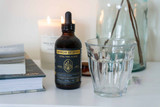Chinese Dietary Therapy for the Autumn Season
Living—and Eating—Seasonally in the Autumn
Today—September 22, 2025—marks the official start of fall in the Northern Hemisphere. The autumnal equinox.
Here in Vermont, the bells of Fall have been tolling for well over a month now. For me, it begins with the morning dew in the grass as I make my way to the vegetable garden. Then comes the chirping, the humming, and the buzzing of the crickets and the cicadas. The cawing of crows. And while these not-so-subtle signifiers of the end of summer always seem to come too soon, they truly are the beginning of the best days of summer—which, more and more, includes the early days of Fall.
And they serve as a reminder to make use of the remaining time I have before winter sets in. Because it will. That’s just how it works.
In the framework of the Five Elements, we move from late summer into autumn, carrying the lessons and abundance of summer into the cooler, quieter, more introspective months. As this cycle proceeds, we bring the spirit of Yì—the intellect—into the spirit of Pò—our corporeal soul, our fleshy bodies. Autumn is the season of nourish and nurture. The season of letting go—of letting go of that which no longer serves us. In this season, we let go of grief, and as we let go of grief we make space for what comes next. We let go, figuratively and literally, so that we can hold on to that which does serve us.
And as the fabric of the Five Elements are woven from threads between the heavens, our bodies, and the earth, it is only logical that our diets should evolve to reflect the changing seasons. The foods we eat—that is, our diets—are how we align ourselves with the seasons, within these cycles.
Through choice and intention, we align ourselves through a practice of nourishment and nurture. And, through choice and intention, we can also choose not to. The choice is personal, and without judgment.

Chinese Dietary Therapy and Seasonal Eating in the Autumn
Organized around the Five Elements, Chinese Dietary Therapy is one of the Five Branches of Chinese Medicine: Acupuncture, Herbalism, Tuī Ná (Massage Therapy), Qì Gōng and Tài Qì, and Dietary Therapy. Each branch of Chinese Medicine is a stand-alone therapy, meaning that each is equal in effect to the others and can be used alone.
Of the Five Branches, Chinese Dietary Therapy is the oldest system of Chinese Medicine, and is the origin of herbalism. As a system of therapy, diet is unique in its frequency and its availability. Eating is a necessity—and it is something we already do multiple times a day.
Chinese Dietary Therapy can be practiced in general guidance and can be practiced for specific health concerns and pathologies. Eating seasonally—Spring, Summer, Late-Summer, Autumn/Harvest, and Winter—is how we practice Chinese Dietary Therapy as a general guidance. Not a set diet or prescription, eating seasonally is a framework that evolves through the year and through our lives.
Of all the five seasons, Autumnal eating is unique in that it provides a once-a-year opportunity to most easily integrate seasonal eating according to Chinese Dietary Therapy, as the recommendations reflect how many of us typically eat already: the macronutrients are balanced (40% carbohydrates, 30% protein, 30% fat), the foods are readily accessible for most people (grains, legumes, nuts, roots, compact fruits), and the cooking methods are straightforward (soups, stews).
Along with late-summer, the season of autumn is the season of harvest: a season energetically marked by descent, consolidation, and storage. It is an energy of gathering and conserving resources—physically, mentally, and emotionally—for the months to come. These energetic qualities are reflected in the diet: From nourishing soups and stews to vegetables like Brussels sprouts to nutrient-dense seeds and nuts.
Rather than a season of isolation, autumn is a season of relaxation, of turning inward, and—perhaps most importantly—it is a season of letting go. Just as the crops are harvested, sorted, and stored for the winter, so too do we harvest, sort, and decide what we will carry with us into the months—and years—ahead. We decide what to keep and what not to keep.
An Overview of the Five Elements and the Five Seasons
This guide focuses on seasonal eating in autumn—yet the seasons do not occur in isolation. The following table provides a very brief outline of seasonal eating in accordance with the Five Elements.
Chinese Dietary Therapy and Seasonal Eating For the Five Seasons
| Season | Element | Zàng-Fǔ Organs | Spirit | Taste | Climatic Factor | Elemental Foods | Examples |
|---|---|---|---|---|---|---|---|
| Spring | Wood | Liver (LV), Gallbladder (GB) | Hún – Ethereal Soul | Sour | Wind | Shoots, sprouts, berries, legumes | Bamboo shoots, leafy greens, sprouts, legumes, berries |
| Summer | Fire | Heart (HT), Small Intestine (SI), Pericardium (PC), Sān Jiāo (SJ) | Shén – Mind/Spirit | Bitter | Heat | Pit fruits, upward-moving foods | Cherries, peaches, apricots, tomatoes |
| Late Summer | Earth | Spleen (SP), Stomach (ST) | Yì – Intellect | Sweet | Dampness | Grains, citrus, tropical fruits | Millet, rice, corn, citrus |
| Autumn | Metal | Lung (LU), Large Intestine (LI) | Pò – Corporeal Soul | Acrid/Pungent | Dryness | Nuts, compact fruits, roots/tubers, dairy | Almonds, walnuts, chestnuts, apples, pears, persimmons, potatoes, sweet potatoes, brassica vegetables |
| Winter | Water | Kidney (KI), Urinary Bladder (UB) | Zhì – Will | Salty | Cold | Seeds, legumes, aquatic foods | Black beans, sesame, lotus seeds, seaweeds, fish |
The Five Elements of Autumn and Harvest in Chinese Dietary Therapy
Autumn and the Five Elements
- Autumn is the season of harvest – Autumn is the time when Qì turns inward, descending, consolidating, and storing.
- Autumn is the energetic season of relaxation, gathering inward, and letting go – Just as we harvest, sort, and store crops, we too sort, select, and conserve our own resources as we prepare for winter.
The Zàng-Fǔ Organs of Autumn
- Lungs (LU) and Large Intestine (LI) – The paired Zàng-Fǔ organs of autumn.
- The Lungs (LU) – Govern Qì, respiration, and defense.
- The Large Intestine (LI) – Governs elimination — physically and emotionally.
- As paired Zàng-Fǔ organs – The Lungs and Large Intestine regulate intake and release, both physically and emotionally.
The Five Element Spirit of Autumn
- The Pò (Corporeal Soul) – The Spirit of Autumn; the Spirit of Metal. Of the Five Spirits, the Pò governs instinct, bodily rhythms, and the capacity to release.
- Grief – The associated emotion of the Pò is grief. When balanced, grief transforms into clarity and presence. The work of autumn is to let go of grief in order to make space for abundance — releasing what no longer serves (through the Large Intestine) to create space for what does (through the Lungs).
- Letting Go – Supporting the Pò in autumn means nourishing the body’s ability to process grief, let go, and root itself in the present.
Taste and Climatic Factor of Autumn
- Taste: Acrid/Pungent – Disperses, opens, and supports the Lungs (LU) in expelling pathogens. Examples: radish, garlic, chives.
- Climatic factor: Dryness – The key environmental challenge of autumn. Dryness can injure the Lungs and deplete body fluids if not counterbalanced. To counter dryness, favor moistening foods such as pears, apples, almonds, sesame, and tremella (wood ear fungus).
The Color of Autumn
- White – The color of autumn, linked to the Lungs (LU) and the element Metal.
- In Chinese Dietary Therapy – White foods are emphasized in autumn to moisten dryness and support the Lungs. Examples: pear, radish, daikon, lily bulb, almonds, dairy.
The Elemental Foods of Autumn
- Compact fruits – Tight, closed, and consolidating, reflecting autumn’s qualities of completion and inward gathering. These fruits consolidate and generate fluids. Examples: apples, pears, persimmons, pomegranates, loquat.
- Nuts – Concentrate energy, symbolize storage, and support the Lungs and Kidneys. In autumn, emphasize almonds, walnuts, chestnuts, and pistachios.
- Roots and tubers – Consolidate, promote descending Qì, and aid peristalsis, supporting the process of letting go. Examples: potatoes, sweet potatoes, Chinese yam, taro, daikon, burdock.
- Dairy – Moistens, counteracting the pathological tendency toward dryness in autumn, and supports the Lungs. Note: dairy is contraindicated in some individuals.
The Cooking Methods of Autumn
While in the West we may not think of cooking methods as part of diet, within Chinese Dietary Therapy the way food is prepared is considered almost as energetically influential as the food itself. Different methods of cooking (e.g., roasting, grilling, stewing) change the nature of foods.
- Emphasize stewing and boiling – Autumn favors moistening, Yin-supporting methods such as stewing and boiling. These protect the Lungs and counter the pathological tendency toward dryness.
- Avoid excessive frying or grilling – Both methods create dryness and heat, which contribute to seasonal pathological tendencies.
The Pathological Tendencies of Autumn
Each season carries its own pathological tendencies. One of the functions of seasonal eating within Chinese Dietary Therapy is to counterbalance — to counteract — these tendencies.
The pathological tendencies of autumn are:
- Dryness – dry cough, dry skin, constipation, dry eyes/mouth.
- Weak Lung (LU) Qì – susceptibility to colds, weak immunity.
- Difficulty letting go – emotional holding, stagnation of grief.
The Therapeutic Goals of an Autumnal Diet
- To moisten the Lungs – Compact fruits, nuts, seeds, and moistening fungi (tremella, tree ear fungus).
- To descend Qì and promote elimination – Root vegetables (daikon, turnip) and pungent spices/vegetables (radish, garlic, chives).
- To store energy – Consolidate with complex carbohydrates (grains, legumes, nuts).
- To harmonize Yīn and Yáng – Prepare soups, stews, and congees to harmonize Yīn and Yáng and to preserve fluids.
Seasonal Eating in the Autumn and Harvest
Chinese Dietary Therapy Recommendations:
- Foods should be local and seasonal.
- Macronutrients Balanced (40/30/30)
- 40% Complex carbohydrates – Primarily from grains, roots, and tubers.
- 30% Protein – From legumes and, when not vegetarian, moderate amounts of animal products.
- 30% Fat – From nuts and healthy oils.
- Primary Food Categories
- Complex carbohydrates – Grains, roots, and tubers.
- Roots and tubers – Potatoes, sweet potatoes, Chinese yam, taro, daikon, burdock.
- Nuts and fats – Almonds, walnuts, chestnuts, pistachios; natural oils in moderation.
- Legumes – Lentils, chickpeas, adzuki beans, black beans (protein sources).
- Cooking Methods
- Emphasize stewing and boiling – Moistening, Yin-supporting methods that protect the Lungs and counter dryness.
- Soups, stews, and congees – Ideal autumn preparations to harmonize Yīn and Yáng while preserving fluids.
- Avoid excessive frying or grilling – These methods create dryness and heat, aggravating autumn imbalances.
Autumn Food Categories and Their Therapeutic Properties
Grains and Legumes
Autumnal eating is focused on seasonally available foods with an emphasis on complex carbohydrates, with the combination of legumes and grains serving as the primary sources of proteins. This approach consolidates and stores energy for the winter, while supporting the descending and releasing functions of the Lungs (LU) and Large Intestine (LI) and counterbalances the pathological tendency toward dryness through moistening foods and cooking methods.
- Favor whole grains – Avoid refined grains such as pizza, pasta, and white rice.
- Choose gluten vs. non-gluten grains – According to your own constitution.
- Emphasize legumes (beans, lentils) – Use legumes as primary protein sources.
- Combine grains and legumes – To create complete proteins.
Nuts and Seeds
Nuts and seeds are strongly associated with autumn and the Metal element, symbolizing consolidation and storage. Nuts and seeds support the Lungs (LU) and Kidneys (KI), and each has its own specific therapeutic actions.
- Metal-associated nuts – Pine nuts, Brazil nuts.
- Almonds – Descend Qì, support Lungs (LU), relieve cough.
- Walnuts – Support brain, memory, Kidneys (KI), relieve constipation.
- Chestnuts – Nourish Jing, hormones, bone marrow.
- Pistachios – “Opening the heart fruit,” support Heart (HT), circulation, sleep.
- Sunflower seeds – Bring Yáng upward, support Lungs (LU); therapeutic in small amounts.
Vegetables – Roots and Tubers
Roots and tubers are emphasized in autumnal diets for their ability to descend Qì, support Lung (LU) Qì, promote peristalsis, and expel pathogenic factors and emotional waste.
- Potatoes – Affinity with the Spleen (SP) and Stomach (ST). Potatoes are cooling and descend Qì; baking and roasting energetically warm them.
- Sweet potatoes – When baked, they engender fluids (helpful for dry eyes and mouth); when boiled, they promote peristalsis.
- Chinese yam – A Qì tonic for the Spleen (SP) and Stomach (ST); reduces blood sugar and drains dampness. While not common in Western grocery stores, it is readily available in Chinese markets.
- Taro – Warming and strengthens Lung (LU) Qì. Always eat taro cooked.
- Jerusalem artichoke – Warming, supports cold extremities and back pain, both useful during the colder seasons.
- Rutabaga – Cooling, consolidates energy, and helps resolve frequent urination.
- Yucca – Cooling, tonifies the Spleen (SP) and Stomach (ST), and has a low glycemic index.
- General roots – Beets, carrots, parsnips, turnips, daikon, and burdock support Lung (LU) Qì and respiration.
- Turnips, daikon – Promote peristalsis and expel pathogenic factors.
Melons and Squashes
Melons and squashes are transitional vegetables, aiding the body as it shifts from summer to autumn and from autumn into winter.
- Autumn transitional vegetables – Zucchini, pumpkin, butternut, acorn.
- Qualities – Tonify Spleen (SP) and Stomach (ST), disperse food stasis, course wind, aid seasonal change.
- Acorn squash – Cooling, supports transition from summer to autumn.
- Butternut squash – Warming, supports transition from summer to autumn.
- Pumpkin – Warming, supports transition from autumn into winter.
Fruits
Compact fruits are emblematic of autumn, reflecting consolidation while moistening the Lungs (LU) and generating fluids. In addition to compact fruits, citrus fruits and mulberries are included to support the Lungs (LU) and nourish fluids.
- Compact fruits – Apples, pears, persimmons, pomegranates, loquat.
- Citrus – Tangerine, pomelo, kumquat; peel tea disperses Lung (LU) Qì and prevents phlegm.
- Mulberries – Steamed or dried mulberries nourish Blood and address autumn deficiencies.
Animal Products and Fatty Foods
Animal products promote Qì consolidation and support hormones and Blood. In autumnal diets, the focus is on fatty meats — pork, sausage, and ham — which specifically support hormones and storage.
- Pork, sausage, ham – Support hormones and storage.
- Vegetarian fats – Nuts, milk, eggs.
- Squid ink – Stops bleeding (hemostatic).
- Chicken gizzards – Strengthen vessels; useful for “restless blood.”
Cooking Methods
When eating for the autumn season, stewing and boiling are emphasized as they are moistening and Yin-supporting, while protecting the Lungs (LU) and counteracting seasonal dryness.
- Stewing/boiling – Yin, moistening, supports the Lungs (LU), and corresponds to the Metal element.
- Avoid deep-frying – Generates heat and dryness.
- Prefer soups and stews – Especially with vegetables and meats.
- Integrate aromatic spices – Coriander, anise, dill, parsley; relieve stagnation and pain.

A Day of Autumnal Seasonal Eating
This menu reflects the therapeutic goals of autumnal eating in Chinese Dietary Therapy:
- Moisten the Lungs (LU) – to counter dryness.
- Descend Qì and aid elimination (Lungs (LU) / Large Intestine (LI)) – To support the downward movement of autumn and of letting go.
- Consolidate and store – energy for winter.
- Harmonize Yīn and Yáng – with warm, moistening foods and cooking methods.
Morning Breakfast
Morning is when Wèi Qì rises and when the Large Intestine (LI) is most active. Eating moistening foods supports elimination and counters dryness.
- Congee with whole grains and legumes – Base of brown rice or millet with adzuki beans.
- Add sweet potato (baked: engenders fluids; boiled: supports peristalsis).
- Top with almonds to descend Qì and relieve cough.
- Optional garnish – Chinese yam as Qì tonic for SP/ST and to drain dampness.
- Steamed or poached pear with honey – Moistens LU, generates fluids.
- Vegan option – Replace honey with maple syrup, date syrup, or omit.
Mid-Morning Snack
Light nourishment consolidates energy without overwhelming digestion.
- Chestnuts – Nourish Jīng, bone marrow, hormones.
- Citrus peel tea – Tangerine peel disperses LU Qì, prevents phlegm.
Midday Lunch – The Main Meal of the Day
In autumn, digestion is strongest at midday. As such, this is the best time for the heartiest meal.
- Root vegetable stew – Daikon, carrot, taro, rutabaga, with lentils or chickpeas.
- Season with coriander and parsley (aromatic, relieves stagnation).
- Grain base – Barley, millet, or brown rice.
- Steamed brassica vegetables – Cabbage, broccoli, or Brussels sprouts.
- Vegetarian option – Add egg or a small amount of dairy (e.g., butter garnish).
- Vegan option – Omit egg, prepare with olive oil or sesame oil.
Afternoon Snack – To Nourish the Blood and Lighten the Mood
Afternoon nourishment supports the Lungs (LU) and Heart (HT) and helps stabilize mood.
- Pistachios – The “opening the heart fruit”; support HT and circulation.
- Mulberries (steamed/dried) – Nourish Blood; helpful for autumn deficiencies.
Evening Dinner
As Wèi Qì rises again at night, moistening and consolidating foods support fluids and prepare the body for rest.
- Pumpkin and butternut squash soup – Warming, supports seasonal transitions.
- Add protein – chickpeas, adzuki beans, or black beans.
- Spice lightly with dill or anise.
- Sautéed celery and bamboo shoots – Relieve stagnation.
- Baked apple with almond drizzle – Compact fruit; moistens LU.
Before Bed – Anchor and Moisten For Sleep
- Warm almond or walnut milk – Moistens the Lungs (LU), supports the Kidneys (KI), and nourishes brain and memory.
Nut and Seed Milks and Chinese Dietary Therapy
Used and prepared therapeutically, nut and seed milks (Hú) are not interchangeable—nor are they synonymous—with what is available in grocery stores.
Instead, these are therapeutic preparations, taken as a daily dose rather than as a milk replacement. These nut and seed milks should be prepared fresh each day according to the following guidelines:
- 2 cups water
- ½ cup pulverized nuts or seeds (e.g., walnuts to support the brain and Kidneys (KI), chestnuts to nourish Jīng, pumpkin seeds to support the prostate, almonds to descend Qì and relieve cough).
- Cook down until you have 1.5–1 cup of liquid
- Strain
This method yields only a small amount—enough for one day as a therapeutic dose.
Additionally:
- Skins (such as on walnuts or peanuts) carry astringent qualities, helping the body retain fluids.
- Seed and nut milks work at the Jīng level, nourishing Yīn and supporting conditions such as dryness or neurological weakness.

An Acknowledgment of Citation, Tradition, and Lineage
This document is compiled from class notes taken during the Chinese Dietary Therapy program (2018–2019), taught by Jeffrey C. Yuen — 88th-generation Daoist priest of the Jade Purity School, Laozi sect, and 26th-generation priest of the Complete Reality School, Dragon Gate sect.
This article is part of a longer series of articles, where we explore Chinese Dietary Therapy throughout the seasons. In addition to Chinese Dietary Therapy for the Autumn and Harvest Season, see Chinese Dietary Therapy for the Winter Season
Site Disclaimers
General Guidence
The content on this site is provided for educational and informational purposes only and should not be construed as medical advice. Always consult a qualified healthcare provider before making changes to your diet, lifestyle, or health regimen, particularly if you are pregnant or nursing, under the age of 18, managing allergies or known sensitivities, or living with any medical conditions.
At RAW Forest Foods, your safety is our priority. Please note that our products are dietary supplements, not medications. The following disclaimer applies:
* These statements have not been evaluated by the Food and Drug Administration. These products are not intended to diagnose, treat, cure, or prevent any disease.
Ingredient Transparency and Allergen Awareness
We are committed to providing transparent ingredient information to help you make informed decisions. If you have or suspect you have allergies to any of our ingredients, we strongly advise against using our products, as allergic reactions can be severe.
Interaction with Medications
If you are taking any medications, consult with your healthcare provider before using supplements. Certain supplements may interact with medications, potentially altering their effectiveness or causing unwanted effects.
For more details, please review our full Terms and Conditions.






